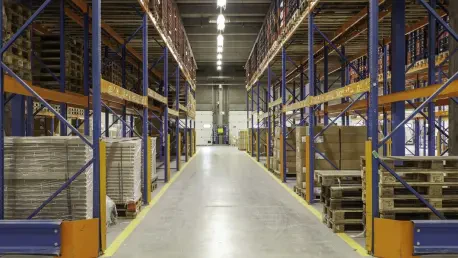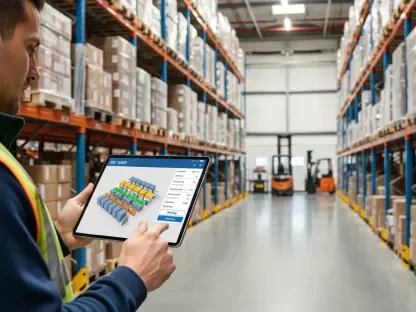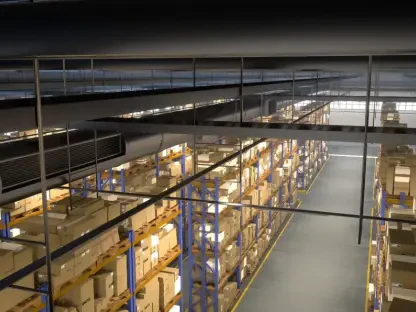Introduction to Racking Systems and Their Critical Role
Imagine a sprawling warehouse where every inch of space is a battleground for efficiency, and a single misstep in storage can lead to hours of downtime or, even worse, a catastrophic accident that disrupts operations entirely. Racking systems stand as the unsung heroes in this high-stakes environment, providing the structure and stability needed to keep operations running smoothly. These systems are far more than mere shelves; they are the foundation of organization, safety, and productivity in modern logistics hubs.
Their significance cannot be overstated, as they directly impact how quickly goods move, how safely employees work, and how effectively a business meets customer demands. With warehouses handling ever-increasing volumes, the role of racking has become even more pivotal. This guide delves into current trends shaping storage solutions, essential safety measures, innovative approaches to design, and valuable insights from industry leaders to ensure optimal warehouse performance.
The focus here is on equipping warehouse managers and business owners with actionable best practices. From understanding why robust racking is indispensable to exploring cutting-edge technologies and safety protocols, this article aims to provide a comprehensive roadmap for leveraging these systems to maximize efficiency while minimizing risks.
Why Racking Systems Are Essential for Warehouse Success
At the core of any thriving warehouse lies a well-designed racking system that transforms chaotic storage into streamlined operations. These structures optimize vertical and horizontal space, allowing businesses to store more in less area, which is critical in facilities where real estate costs are a significant expense. Without such systems, disorganization can lead to delays, misplaced inventory, and frustrated workers.
Beyond space management, racking systems deliver substantial benefits in efficiency and safety. Properly implemented setups reduce the time spent searching for items, thereby speeding up order fulfillment and minimizing operational bottlenecks. Additionally, they contribute to a safer workplace by preventing haphazard stacking that could result in falls or injuries, while also cutting costs associated with downtime or accident-related losses.
Industry experts universally agree on the necessity of adaptable and sturdy racking to address growing demands. As e-commerce continues to surge, warehouses must handle diverse product ranges and fluctuating inventory levels. A reliable racking infrastructure ensures scalability, enabling businesses to pivot quickly without sacrificing safety or performance, thus securing long-term success in a competitive market.
Best Practices for Implementing Effective Racking Systems
Selecting, maintaining, and upgrading racking systems requires a strategic approach tailored to specific operational needs. The first step is assessing warehouse requirements, such as load capacities, product types, and turnover rates, to choose a system that aligns with both current and future demands. Investing in quality materials and designs from the outset can prevent costly replacements down the line.
Safety and innovation must be integral to any storage solution. This means not only adhering to industry standards but also anticipating potential hazards through proactive planning. Regular training for staff on proper loading techniques and system usage is vital, as is staying informed about advancements that could enhance functionality or security within the warehouse environment.
Guidance from industry leaders emphasizes the value of a holistic perspective when implementing racking systems. Collaboration with experienced suppliers can provide insights into customized configurations that boost efficiency. Furthermore, establishing a culture of continuous improvement ensures that racking solutions evolve alongside operational growth, maintaining relevance and reliability over time.
Prioritizing Safety with Proactive Maintenance and Guidelines
Safety in racking systems begins with strict adherence to established protocols and legal requirements. Resources like comprehensive safety guides outline critical steps for maintaining structural integrity, such as conducting routine inspections to identify wear and tear. Compliance with these standards is non-negotiable to protect workers and avoid penalties or operational disruptions.
Proactive maintenance plays a key role in risk mitigation. Scheduling regular checks for signs of damage, ensuring load limits are respected, and promptly addressing issues like bent frames or loose bolts can prevent devastating rack collapses. Documenting these inspections also helps in tracking the condition of systems over time, providing a clear record for accountability and improvement.
Beyond maintenance, fostering a safety-first mindset among employees is essential. Training programs should cover proper handling of goods and awareness of potential hazards around racking structures. By embedding these practices into daily routines, warehouses can significantly reduce the likelihood of workplace injuries and maintain a secure, efficient operation.
Investing in Customizable and Durable Racking Designs
Versatility in racking systems offers a competitive edge for warehouses with diverse storage needs. Solutions like longspan and rivet racking demonstrate exceptional adaptability, supporting heavy loads while allowing reconfiguration for different applications, such as organizing bulky tires or delicate garments. This flexibility ensures that storage evolves with inventory changes.
Durability is equally critical when selecting racking designs. Systems built to withstand significant weight and frequent use reduce the need for frequent repairs or replacements, offering long-term cost savings. Prioritizing materials known for strength and resilience can make a substantial difference in maintaining operational continuity under demanding conditions.
When choosing racking, consulting with suppliers who understand specific industry challenges is advisable. Tailored designs that account for unique factors like temperature extremes or high turnover can optimize performance. This approach not only addresses immediate storage requirements but also builds a foundation for scalability as business needs expand.
Leveraging Advanced Safety Technologies
Incorporating cutting-edge safety technologies into racking systems marks a shift toward prevention rather than reaction. Innovations such as rack collapse prevention mechanisms are designed to protect against impacts and overloading, addressing common causes of structural failure. These tools are becoming indispensable in high-traffic warehouses where risks are amplified.
Integration of such technologies should begin at the design and installation stages. Working with experts to embed safety features like impact-resistant barriers or automated load monitoring ensures that systems are future-proofed against evolving hazards. This proactive approach minimizes downtime and enhances overall security within the storage environment.
Beyond installation, ongoing evaluation of safety technologies is necessary to keep pace with industry advancements. Regular updates or upgrades to existing systems can address new risks as they emerge. By prioritizing these innovations, warehouses can create a safer workplace while maintaining the efficiency that racking systems are designed to deliver.
Conclusion: The Future of Racking Systems in Warehouse Management
Looking back, the exploration of racking systems revealed their undeniable status as the backbone of warehouse efficiency, seamlessly blending functionality with safety and innovation. Each best practice discussed highlighted a commitment to balancing operational demands with the imperative of risk management. The journey through safety protocols, customizable designs, and advanced technologies painted a clear picture of an industry dedicated to progress.
Moving forward, warehouse managers and business owners should prioritize adaptability, durability, and safety when selecting racking solutions. A critical next step involves conducting thorough assessments of current systems to identify gaps in performance or security, followed by strategic investments in upgrades that align with specific industry needs and budget constraints.
Staying abreast of technological advancements and evolving safety standards will be paramount in maintaining a competitive edge. Engaging with industry networks and suppliers for the latest insights can guide decisions on integrating new solutions. By taking these actionable steps, businesses can ensure that their racking systems remain robust and responsive to future challenges, securing efficiency for years to come.









